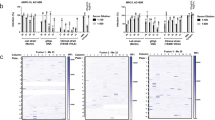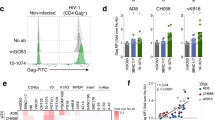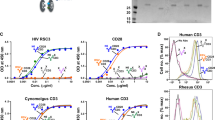Abstract
MOLECULAR fusions of CD4, the receptor for human immunodeficiency virus (HIV; refs 1—4), with immunoglobulin (termed CD4 immunoadhesins) possess both the gpl20-binding and HIV-blocking properties of recombinant soluble CD4, and certain properties of IgG, notably long plasma half-life and Fc receptor binding5,6. Here we show that a CD4 immunoadhesin can mediate antibody-dependent cell-mediated cytotoxicity (ADCC) towards HIV-infected cells, although, unlike natural anti-gpl20 antibodies, it does not allow ADCC towards uninfected CD4-expressing cells that have bound soluble gpl20 to the CD4 on their surface. In addition, CD4 immunoadhesin, like natural IgG molecules, is efficiently transferred across the placenta of a primate. These observations have implications for the therapeutic application of CD4 immunoadhesins, particularly in the area of perinatal transmission of HIV infection.
This is a preview of subscription content, access via your institution
Access options
Subscribe to this journal
Receive 51 print issues and online access
$199.00 per year
only $3.90 per issue
Buy this article
- Purchase on Springer Link
- Instant access to full article PDF
Prices may be subject to local taxes which are calculated during checkout
Similar content being viewed by others
References
Dalgleish, A. et al. Nature 312, 763–767 (1984).
Klatzmann, D. et al. Nature 312, 767–768 (1984).
Maddon, P. et al. Cell 47, 333–348 (1986).
McDougal, J. et al. Science 231, 382–385 (1986).
Capon, D. et al. Nature 337, 525–531 (1989).
Traunecker, A., Schneider, J., Kiefer, H. & Karjalainen, K. Nature 339, 68–70 (1989).
Lyerly, H. Matthews, T., Langlois, A., Bolognesi, D. & Weinhold, K. Proc. natn. Acad. Scl. U.S.A. 84, 4601–4605 (1987).
Katz, S. & Wilfert, C. New Engl. J. Med. 320, 1687–1688 (1989).
Dancis, J., Lind, J., Oratz, M., Smolens, J. & Vara, P. Am. J. Obstet. Gynec. 82, 167–171 (1961).
Gitlin, D., Kumate, J., Urrusti, J. & Morales, C. J. clin. Invest 43, 1938–1951 (1964).
Till, M. et al. Science 242, 1166–1168 (1988).
Chaudhary, A. et al. Nature 335, 369–372 (1988).
Johnson, P. & Brown, P. Placenta 2, 355–369 (1981).
Smith, D. et al. Science 238, 1704–1707 (1987).
Kabat, E. et al. Sequences of Proteins of Immunological Interest 4th edn (1987).
Zoller, M. & Smith, M. Nucleic Acids Res. 10, 6487–6500 (1982).
Lasky, L. et al. Science 233, 209–212 (1986).
Howell, D., Andriotti, P., Dawson, J. & Cresswell, P. J. Immun. 134, 971 (1985).
Nakane, P. & Pierce, G. J. Cell Biol. 33, 307–318 (1967).
Marquardt, D. J. Soc. ind appl. Math. 11, 431–441 (1963).
Author information
Authors and Affiliations
Rights and permissions
About this article
Cite this article
Byrn, R., Mordenti, J., Lucas, C. et al. Biological properties of a CD4 immunoadhesin. Nature 344, 667–670 (1990). https://doi.org/10.1038/344667a0
Received:
Accepted:
Issue Date:
DOI: https://doi.org/10.1038/344667a0
This article is cited by
-
The biological effects of endogenous nerve growth factor on adult sensory neurons revealed by a trkA-IgG fusion molecule
Nature Medicine (1995)
-
Biological and pharmacokinetic properties of a novel immunoglobulin-CD4 fusion protein
Archives of Virology (1994)
-
Antiviral effects of different CD4-immunoglobulin constructs against HIV-1 and SIV: immunological characterization, pharmacokinetic data and in vivo experiments
Archives of Virology (1993)
-
Characterization and anti-HIV properties of CD 4-coated red blood cells
Archives of Virology (1992)
Comments
By submitting a comment you agree to abide by our Terms and Community Guidelines. If you find something abusive or that does not comply with our terms or guidelines please flag it as inappropriate.



